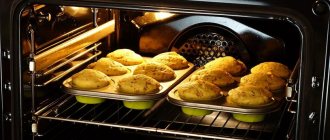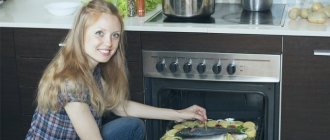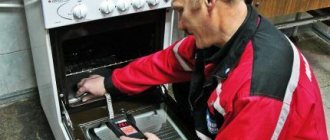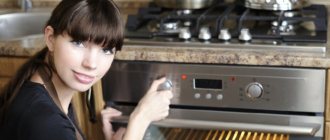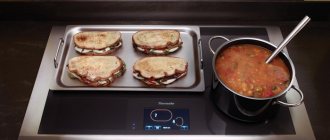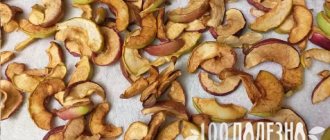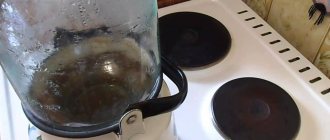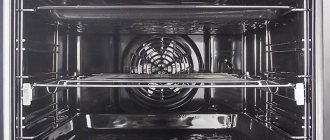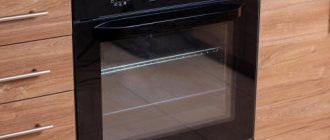The oven is one of the successful inventions of mankind; it has long taken root in everyday life. The first solid fuel oven was proposed by inventor William Flavel in 1830.
Almost all types of hobs in the kitchen have an oven.
Then solid fuel was replaced by kerosene, and then gas replaced it. And for many generations of people, they have been preparing various culinary delights in such a device and delighting their families with delicious dishes. Dishes cooked in the oven are much tastier and healthier than dishes cooked on the stove or in a modern microwave oven.
All the functions of modern ovens allow you to cook delicious and healthy food.
When cooking in the oven, large quantities of oil are not used and magnetic waves are not used - the food turns out environmentally friendly. At the same time, the dishes come out with a fragrant crust and an appetizing flavor. But how to use the oven has its own secrets and nuances.
Cooking in the oven will give you healthier food than frying in oil.
Instructions for use of the device
The most important thing is that the oven must be installed and connected correctly. You need to be especially careful when connecting the gas stove.
The device must be reliably isolated from adjacent furniture, in addition, there must be air gaps between its walls and the walls of the furniture. The gas supply must also be reliably isolated.
The oven must be installed correctly.
Ovens are divided into gas and electric. The former are heated using an internal gas burner, the latter - using a heating element or tubular electric heater.
A gas oven is an economical option.
Gas stoves are more economical to operate. Electric stoves have more technical capabilities for temperature control and other modes.
An electric oven gives you more technical options.
For several decades now, gas stoves with electric drive have been produced, which are much more convenient to use. Such devices have electric ignition of burners, a grill spit, and a convection function. Thanks to this, modern appliances are more convenient, but it is important not to forget the basic rules of how to use a gas oven.
Electric ignition is a very convenient feature of modern stoves.
Important! If a gas oven is installed at home, then if you are away from home for a long time, the gas must be turned off for safety reasons.
How to use a gas oven
Before you start using it, you need to remove everything unnecessary from the device, leaving only a baking sheet or wire rack inside. They must be at the required level for cooking. As a rule, the unit has three options for installing a baking tray or grid.
You need to turn on the gas and light the burners. Most modern stoves have electric ignition of the burners, so you just need to turn on the device.
Lighting the oven is simple - use the electric ignition.
Next, you need to set the temperature level to which the oven should warm up and wait for it to warm up. This usually takes 10-15 minutes.
After this, you need to put the dish with food in the oven and wait for it to cook. You should not open the stove door often - this will only increase the cooking time and weaken the taste and aroma of the cooked food. It is better to watch the cooking through the heat-resistant glass of the oven.
Food cooked in the oven is healthier than on the stove or in the microwave.
When using the oven, you can use any heat-resistant cookware:
- strained glass,
- metal,
- cast iron,
- silicone,
- ceramic and enamel dishes.
Use special heat-resistant dishes for cooking in the oven.
How to use an electric oven
Electric models are created on the same principle as gas ones. Therefore, the rules for using an electric oven are similar to operating a gas appliance.
The only difference is that heating elements can be located at the top and bottom, which increases the heating of food and provides additional opportunities for culinary creativity.
Often the device is also equipped with convection - a special fan that provides strong air circulation. Thanks to the fan, the heat in the oven is distributed more evenly and the food does not burn. But the fan significantly dries out the food.
Convection is a very useful oven function.
Before use, the oven also needs to be warmed up well, which can be done using top and bottom heat. Next, set the desired temperature, desired heating option, and timer. All that remains is to load the dishes with the dish and enjoy cooking.
Before putting the dish in the oven, you need to preheat the oven well.
Grill
The grill is a tube-shaped element that is attached to the ceiling of the oven. It differs from a simple heating element, including the top one, in the specificity of its impact - using infrared radiation. It heats not the air, but the food itself. The grill radiation acts strictly under the element, that is, placing sausages or chicken legs slightly to the side will make it difficult to achieve the desired result.
The grill can be used as the main cooking mode, as well as at the final stage, when you want to appetizingly brown the dish.
Manufacturers are unanimous in the name of this mode; only the Hotpoint-Ariston company calls it barbecue, and Gorenje calls it infraheating.
Grills come in several varieties.
The usual one is U-shaped or in the form of a zigzag, the sphere of its “interest” is the entire area of the lattice. Some models use a more economical option - a grill with two circuits, small inside (for example, the so-called middle part of Neff) and large along the perimeter of the ceiling.
The small circuit is included if the portions are small, for example, 4 pieces of toast or several thin pieces of meat. And big and small together in the case when the products are spread out over the entire grill. Grills can differ not only in area, but also in power, so it’s easy to choose softer or, on the contrary, stronger grilling.
Grills can operate exclusively at maximum (meaning their own temperature limit, for example, 250 ° C for Ardo, 200 ° C for Kaiser, or 180 ° C and 220 ° C for Neff), but often manufacturers produce ovens with variable power elements to adjust the intensity frying, say, Whirlpool has 5 power levels, or an oven with a choice of operating temperatures.
The oven is preheated for 3 or 5 minutes, as recommended in the instructions from Gorenje and Ardo; Neff experts suggest preheating it for 10 minutes, but only for frying toast. The cooking level is upper or one level lower, depending on the thickness of the pieces of meat. Frying is most often done on a grate, and to prevent fat from burning and dirtying the bottom, a tray is placed on the lower level; water can be added to it to avoid smoke and fumes.
Examples of using the grill: steaks, sausages, bacon, frankfurters, kupaty, chops, liver, rolls, hearts, fish fillets, vegetables, toast, as well as dishes in small or large ramekins.
Comment from the Indesit Company press service: “The crispiness is ensured by infrared radiation, which is applied directly to the top layer, i.e. on the crust. The upper heater operates at maximum, the moisture quickly evaporates - this provides a “crunch”, and the surface burns, which gives the golden color of the finished dish. When using heating elements, the impact occurs indirectly
onto the surface, and first the air is heated, and then the dish itself. Accordingly, the effect is no longer the same"
Introduction to basic oven functions
| Heat | Depending on the location of the heating element, it can be upper, lower or annular. The ring heating element is located vertically on the back wall of the device. A gas oven only has bottom heat. |
| Convection or fan | Distributes hot air evenly throughout the oven using a fan. Allows you to cook on several grates of different levels at once. Significantly reduces cooking time. |
| Skewer | Used for frying large pieces of meat and whole chicken. The spit is inserted into a special mechanism in the oven, which turns the food and thus distributes the heat evenly. |
| Grill | Helps prepare dishes with a crispy crust. This function must be used carefully so as not to burn the food. |
| Steam function | Suitable for preparing delicate dietary foods. Not available in all ovens. |
| Drying | Designed for drying berries, mushrooms, fruits, meat. Can be used with a fan and different heating options. |
| Thermostat | Maintains a certain temperature in the oven for a long time. Suitable for keeping food warm, for defrosting and for cleaning the oven. |
| Temperature probe | Allows you to control the temperature inside the dish itself using a special probe and displays it on the oven display. Not available in all devices. |
| Self-cleaning oven | Allows you to easily separate fat and carbon deposits from the walls of the oven. Then all that remains is to wipe the oven. It can be steam or pyrolytic. |
| Timer | Modern ovens are equipped with a time counter. The timer will carefully turn off the device at the right time. Thanks to this, you don’t have to monitor the cooking time yourself. |
Modern ovens allow you to cook several dishes at once. They have many functions and help make cooking quick and easy.
Rules of care
The shelf life of the inverter cooker, established by the manufacturer, is only 15 years, but if it is handled carelessly, it can easily be shortened.
Proper operation of the unit will not only ensure a full period of use, but will also extend it. It is worth paying attention to the basic rules of care
- Preparation for use. The new stove must be cleaned of packaging residues and washed with a soap-salt solution. Otherwise, when you turn on the stove for the first time, there will be a burning smell in the kitchen until the layer of factory grease burns out.
- Purity. Do not leave dirt on the surface. If something spills on the stove while cooking, it is better to wipe it up immediately. When stains or food residues dry, they become more difficult to remove and can scratch the surface.
- Dishes must be used with a flat bottom. Curved bottoms can deform the cooking zone; it will heat up unevenly, providing an uneven load on the panel.
- Do not place wet dishes on the stove. It is better to place containers with cold water not on a heated surface. Uniform heating of the cookware and its contents will extend the life of the stove.
- The stove must always be dry when switched on. When the burners are operating in heating mode, do not allow liquid to come into contact with them, so as not to cause a sudden temperature change. The fragile panel may develop cracks. The surface can only be washed with the burners turned off.
- An empty burner should not be left on at full power. This overloads the heating element and can quickly damage the cooking zone.
- No mechanical damage. Avoid accidental impacts of the surface and falling of various objects onto it. Glass ceramics or tempered glass are quite fragile materials. You should not hang dishes and various household kitchen utensils above the hob to dry.
- The stove is not a place for storage. If we are used to having a kettle “living” on one of the burners of our gas stove, then this will not happen with an inverter stove. You cannot store dishes on a glass-ceramic surface, especially those made from fusible materials. If you accidentally turn on the oven, the dishes may be damaged, and an empty kettle may simply burn out.
To learn about the features of touch-sensitive electric stoves, see the following video.
Every housewife strives to please her loved ones with delicious borscht or golden buns. The quality of food largely depends on the stove. Of course, with some skill, first-class dishes can be prepared on the most common gas stove, but modern hobs provide much more opportunities for this. Captivated by the convenience and appearance of the new device, the owner of this modern miracle will inevitably face the question of how to turn on the electric stove. Now we will discuss this.
Starting the oven for the first time
Before using the oven for the first time and preparing delicious dishes, it must be prepared in a certain way. First, the oven must be washed inside, this will remove any remaining technical oil or grease.
Then the unit must be calcined along with all the grates. To do this, turn it on at 350 degrees for 20 minutes, after which the device is allowed to cool.
Calcining the equipment will remove all residues of machine oils, lubricants, detergents and other harmful substances that are not at all intended for food. After this, you can safely use the oven.
Before starting the oven for the first time, it must be thoroughly washed, thereby getting rid of factory grease and dirt obtained during transportation.
Rating of electric stoves
The choice of electric stove should be based on a rational and thoughtful decision. When going to the store, you should understand what power model is suitable for a particular family, how many burners are needed for the convenience of the housewife, and what price range you should expect. It will be useful to study the ratings of countertop electric ranges from different manufacturers before visiting the appliance department.
- Gemlux GL-IC3510PRO
- a modern model of induction cooker from a famous Italian manufacturer has many advantages, including 10 operating modes, stainless steel coating, and a built-in timer. The only disadvantage of this single-burner model is its high cost. - Kitfort KT-101
is a tabletop electric stove with a glass-ceramic surface, several operating modes and high power with low energy consumption. - Dream 111T BN
is a domestic model that is still in demand in stores; this spiral electric stove was popular in Soviet times. The lack of smooth adjustments is a disadvantage of this model; housewives had to adapt so that the food does not burn.
Heating modes
An electric oven has more functionality and a range of options than a gas oven. Therefore, it is important to know how to use an electric oven correctly, getting maximum convenience and benefit from it.
In a gas device, at best, there is only bottom heating and a fan. In an electric one, there can be three heating modes at once - lower, upper and ring.
In combination with a fan, they provide a huge number of cooking possibilities - from defrosting and stewing to frying kebabs and drying crackers.
An electric oven can have three heating modes at once - bottom, top and ring.
Top and bottom heating
The combination of two heating methods at the same time allows you to fry food to the highest quality and at the same time prevent it from burning. With this mode, dishes are prepared very quickly and the result is a fragrant, crispy crust. Suitable for meat, vegetables, potatoes.
These heating modes allow you to quickly fry food on all sides at once.
Top and bottom heating plus fan
These modes, when operated simultaneously, ensure fast and even frying of food. In this case, the heat is distributed evenly throughout the entire volume of the oven.
When both heating elements are turned on at medium temperature, a drying mode is obtained, intended for preparing dry berries and fruits. At low temperatures, this combination is used to heat and defrost food.
With the help of a fan installed in the oven, heat is quickly and evenly distributed throughout the entire volume of the oven.
Bottom heating
This type of heating is suitable for bulky dishes that require a long time to fry. Ideal for cakes or pies. With this option, biscuit and yeast dough is prepared well, resulting in delicious pies, buns, and buns. Once a large cake is cooked, you can “brown” it using top heat.
This function is well suited for preparing a variety of baked goods.
Bottom heating plus fan
This mode allows you to fry large volumes of baked goods well. Thanks to the fan, heat is distributed more evenly. In addition to baking, it is suitable for semi-finished products, fish, and frozen foods.
This heating will allow you to cook large volumes of baked goods.
Top heating
This mode is necessary for frying meat, potatoes, vegetables and fish. Can be used to give a beautiful crust to already prepared dishes. Using this mode, the upper part of the dish is warmed up well and actively, while the lower part does not burn.
The top heating function is suitable for dry baking and drying.
Top heating and fan
This combination is suitable for preparing dry baked goods – cookies, brushwood, crackers, waffles. Products are quickly heated, fried and dried at the same time.
Ring heater and fan
The ring heater is located in the vertical part of the oven around the fan. Its work is necessary both for heating food and for preparing delicate stews - meat in a pot, soups, stewed potatoes and others.
This function in the oven is necessary for heating and cooking delicate dishes.
Ring heater, fan and bottom heating
The combination of these cooking options is suitable for stewing large volumes of dishes, as well as for preparing stewed food.
Ring heater, fan plus bottom and top heating
The maximum combination of heating options gives a good and fast frying. At low temperatures, this option can be used effectively for defrosting and heating food. At medium temperature, this combination will effectively dry meat and mushrooms.
At low temperatures you can quickly defrost and reheat food.
Grill
The oven option is necessary for cooking large pieces of meat, chicken, and kebabs. It browns food well, especially on the top level. This makes the meat soft and tender. The grill makes it easy to cook toast.
You can use the grill to cook meat, vegetables and toast.
Grill and top heat
The cooking method makes it suitable for kebabs, steaks, and large pieces of meat. Gives the meat a crispy crispy crust and creates a “charcoal-grilled” effect.
Grill and fan
With this type of oven operation, the heat is evenly distributed throughout the entire volume of the cabinet and the dishes turn out soft, but crispy. Effective for meat and fish recipes.
With the help of a fan, hot air is evenly distributed throughout the oven and the dishes turn out soft but crispy.
How to choose a level
Professional chefs indicate in their recipes the level at which they need to cook: the juiciness of the finished dish, the uniformity of baking and the presence of a crust depend on it.
If the cooking recipe does not indicate a level, cook the dish at a medium level.
Lower level. Suitable for simmering at low temperatures, as well as for dishes that need to be well baked on the bottom, but not too dry on top.
Pizza and open pies are cooked on the lower stage
Average level. This level is considered universal: products are baked evenly and remain juicy. Used for dishes with moderate cooking temperatures.
Top level. Used for quick cooking, crusting and high temperature cooking.
Baking in a sleeve or foil allows you to achieve juiciness and softness of the dish.
Clean your oven regularly: dried grease and food residues will burn during cooking and produce an unpleasant odor.
Safety regulations
Since the oven is connected to electricity, and some models are connected to gas, you should know how to use the oven, observing safety precautions.
- Do not use faulty equipment. If the unit does not work as it should, it should be turned off immediately and a technician should be called.
- Under no circumstances should children be allowed to play with the oven or come close to a working unit.
- Do not use the oven to heat the room. This is not a fireplace: there is little aesthetic pleasure and romance, but there are many opportunities to get burned or even start a fire.
- Do not leave the oven turned on unattended. If there are small children or animals in the house, then you shouldn’t even go to another room for a long time.
- When placing dishes in and out of the cabinet, you must use special gloves.
- It is prohibited to store flammable substances near the device.
- The electrical cable must not come into contact with any parts of the oven.
Before using the oven for the first time, you must familiarize yourself with the rules for using this household kitchen appliance.
About gas pressure
Are you planning a big move to a new building? You can forget about the gas stove. Unfortunately, gas supply is not possible in modern residential high-rises. What can we say, even in old 5-9 storey buildings you often encounter the fact that gas simply “does not reach” the apartment due to low pressure.
This is where the creativity of housewives comes into play. Some people light a fire with a branch from a broom, and some make a paper rope. If you are “lucky enough” to encounter a problem with low gas pressure, first release it.
After this, roll the paper into a tube, wet the end you hold in your hand with water, and set the other on fire. Use this “miracle design” to light the oven. Do this only as a last resort if necessary. If there is none, call a gas specialist. There is no point in taking on the “headache” of someone else’s responsibilities.
Features of first use
If you are going to turn on a new oven, then first of all you need to familiarize yourself with the manufacturer’s individual recommendations. As a rule, the sales consultant will recount important information. Despite this, it is better to personally familiarize yourself with the operating algorithms given in the instructions.
During production, protective films, oils and paraffins are often used. The device must be cleaned of all this. First of all, you need to remove all coverings and thoroughly wash the oven surfaces.
After cleaning, washing, drying, the cabinet needs to be calcined. For this purpose, it is turned on at maximum temperature for 1-2 hours. This procedure will remove any remaining preservatives and avoid the influence of chemical odors on the prepared dishes (and the question of what exactly to cook can be answered by a new bracelet that selects products taking into account the DNA of its owner). By the way, this procedure is also recommended for new utensils that are supposed to be used for cooking.
In addition, the user will have to get used to the new oven. This process is complete when the cook is able to determine:
- the optimal position of the adjustment knob to achieve the desired temperature;
- the required position of the baking sheets for preparing a certain dish;
- approximate warm-up time.
It is important to use the correct oven startup algorithm from the very beginning. Sometimes it is enough to break it just once to ruin the oven.
Rules of care
The shelf life of the inverter cooker, established by the manufacturer, is only 15 years, but if it is handled carelessly, it can easily be shortened. Proper operation of the unit will not only ensure a full period of use, but will also extend it.
It is worth paying attention to the basic rules of care
- Preparation for use. The new stove must be cleaned of packaging residues and washed with a soap-salt solution. Otherwise, when you turn on the stove for the first time, there will be a burning smell in the kitchen until the layer of factory grease burns out.
- Purity. Do not leave dirt on the surface. If something spills on the stove while cooking, it is better to wipe it up immediately. When stains or food residues dry, they become more difficult to remove and can scratch the surface.
- Dishes must be used with a flat bottom. Curved bottoms can deform the cooking zone; it will heat up unevenly, providing an uneven load on the panel.
- Do not place wet dishes on the stove. It is better to place containers with cold water not on a heated surface. Uniform heating of the cookware and its contents will extend the life of the stove.
- The stove must always be dry when switched on. When the burners are operating in heating mode, do not allow liquid to come into contact with them, so as not to cause a sudden temperature change. The fragile panel may develop cracks. The surface can only be washed with the burners turned off.
- An empty burner should not be left on at full power. This overloads the heating element and can quickly damage the cooking zone.
- No mechanical damage. Avoid accidental impacts of the surface and falling of various objects onto it. Glass ceramics or tempered glass are quite fragile materials. You should not hang dishes and various household kitchen utensils above the hob to dry.
- The stove is not a place for storage. If we are used to having a kettle “living” on one of the burners of our gas stove, then this will not happen with an inverter stove. You cannot store dishes on a glass-ceramic surface, especially those made from fusible materials. If you accidentally turn on the oven, the dishes may be damaged, and an empty kettle may simply burn out.
To learn about the features of touch-sensitive electric stoves, see the following video.
Rules for using utensils
When choosing cookware for an electric stove, take into account not only the material of manufacture, but also its size. The size of the bottom should not exceed or be less than the size of the burner. A discrepancy of 1 cm is allowed. A large diameter will lead to uneven heating, a small one will lead to unnecessary energy consumption.
Do not place dirty or wet kitchen utensils on the stove. This leads to corrosion on the metal surface, plaque formation on the glass, scratches and other damage. Liquid splashing out is dangerous for glass ceramics. The lids on the utensils used must be tightly closed.
Temperature regulation rules
How to make the touch plate obedient? First of all, we study the rules for handling heating electric disks.
- We place the dishes with the future dish on the electric disk only when it is at its maximum heat. Typically the cooker should start working when the food is on the cutting board.
- Do you plan to simply reheat the dish or simmer it (that is, a decreasing temperature is required for cooking)? We heat the disk to full heat, place the pan with food and immediately turn it off.
- If the dish still needs to be cooked for a long time, and the glass-ceramic disk is heated to the point of redness, turn it off to avoid burning of the food, and remove the dishes for a couple of minutes. After cooling, set the minimum or average temperature for the desired disk and continue preparing the dish further.
- It is better to cook dairy dishes at a decreasing temperature: bring the milk to a boil and begin to reduce the heat of the disk by one at regular intervals.
- We prepare dishes without water (stewing and frying) according to the following scheme: we bring the heating temperature of the disk to maximum (the glass on top of the disk heats up to a bright red color) and at regular intervals we lower the temperature by one.
- Cookers from different manufacturers have different numbers of heating power levels - from 5 to 10. Accordingly, we calculate the time to reduce the heating temperature by dividing - cooking time / number of levels = time after which we reduce the temperature. For example, the approximate cooking time is 30 minutes, power levels are 6: 30 / 6 = heat unit is reset every 5 minutes.
- Cooking in water also has its own characteristics. Since utensils with tight-fitting lids are used for cooking, significantly less water (milk or broth) is consumed: to prepare porridge, instead of 1 liter according to the recipe, we take 900 ml; for cooking vegetables (potatoes, carrots, beets) - from 100 to 300 ml (it is advisable to use dishes with a small diameter).
- At the first appearance of steam under the rim of the pan, lower the temperature or turn off the stove so that during vigorous boiling the water does not “jump out” onto the hot glass surface.
- We prepare the first dishes without adding 3-4 fingers of water to the top of the pan.

